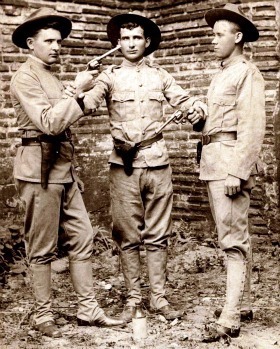Blog comment of the day: Here's how the Army screwed up its museum situation

From a suspiciously well-informed "Unicorn":
Some
facts:
First
the Army doesn't actually own enough in the way of museum worthy artifacts to
fill a central museum even if one were to be built. Most of the nation's
preserved history at arms was accomplished by the far larger militia in whose
states that history was and is preserved (see for examples the Ohio Historical
Society or the New York 69th ).
With
the exception of the West Point teaching museum (on the old Ladycliff campus)
the central Army and its general staff actually have very little in the way of
artifacts. What does exist in the 1/3 of the Army that is active is: a) mostly
WWII or after and that b) firmly in the hands of fort, camp and station museums
that are 501 C3 outfits which have been in existence for years and have become
part of the local communities' tourism base, as well as touchstones to unit
identity (see for example the Airborne Museum). Over the decades of dreaming of
a super army central museum there have been more than a few attempts by the
Army general staff to gather "their" collection by demanding those "local"
collections be made available for the to be built central facility. The
reactions were predictable: "hell no" is a fair summary of those responses.
What
the active Army does have is a large collection of art, mostly bad, all WWII
and some after (including a vast store of really, really bad Nazi art ironically
preserved aside Norman Rockwell pieces) that never sees the light of day. They
are so protective of it that whenever a senior general or civilian asks for
some to decorate their offices, it is supplied, but as a very expensive on
cardboard fake (see the portraits of the former Army Secretaries and Chiefs of
Staff in the Pentagon - all are on card board fakes - the real "art" is in
secure storage. The explanation for this is to prevent any of it being harmed
should the Pentagon be attacked again. In case you were wondering, it is all
housed in a high rise and high rent building in downtown DC just off of K
Street. Go figure.
Second,
the history of the many aborted sites for this central museum could be a novel
in itself. In spite of a wealth of evidence that large scale museums only
thrive (generating visitor traffic sufficient to cover the huge cost of a big
central facility) when they are near other tourist attractions, making them
part of a "destination experience" (see Disneyland), the Army has always tried
to find out of the way places far from other things. This is best exemplified
by the location of the moment - in the middle of Ft Belvoir, a place where even
the local county commissioners say there is so much traffic it is impossible to
get to, and there is zero else to do nearby making it a most UNdestination
experience for tourists.
The previously aborted sites (the Mall, the Marriot Twin Bridges etc) each have
their own sad tales; the current location was selected after the Army declined
the opportunity to obtain for ONE DOLLAR the southern half of the Washington
Navy Yard (then empty). Completely build out ready, this huge site had acres of
land to build on, to parade, river front access for ducks etc, located adjacent
the Navy's National Museum, close to two interstate highways, a Metro stop at
the front door, the Capital barely 5,000 feet away, etc, etc. In short, this
was a museum location of unbelievable potential. Instead the Army general staff
convinced Louis Caldera and his Chief to trade that site for something at
Belvoir (with John Warner in exchange his support) for several Stryker brigades
that the Army was going to get anyway. You can't make this stuff up.
Unicorn
out
Thomas E. Ricks's Blog
- Thomas E. Ricks's profile
- 437 followers



